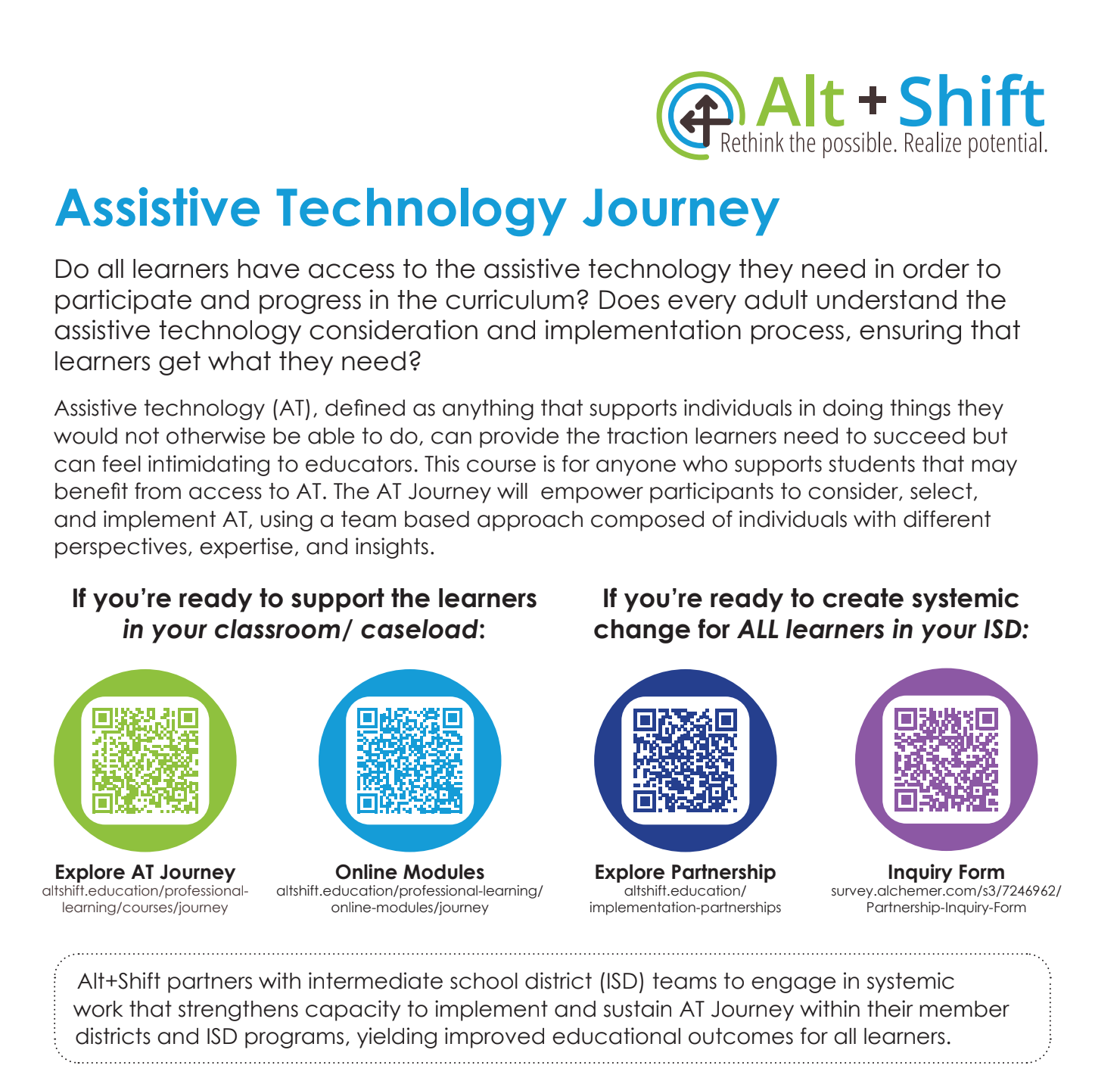AT Journey

Assistive technology (AT), defined as any tool or service that supports learners in doing things they would not otherwise be able to do, can provide the traction learners need to succeed. AT is often intimidating to educators. Staff participating in the AT Journey will be empowered to:
- Consider, select and implement AT for their students
- Recognize when additional perspectives (e.g., teacher, administrator, itinerant staff, paraprofessional, parent, etc.) are critical to this process
- Develop a team-based approach and systems that support students requiring AT
Stop 1: Getting Started on Your AT Journey
Goal:
In this stop, participants will learn the importance of gathering input from all stakeholders when developing AT teams.
Objectives:
Participants will:
- Compare and contrast an “expert” vs “expertise” mindset
- Explain the importance of eliminating silos in education
- List potential stakeholders who could provide input on the provision
Stop 2: Understanding the Fundamentals of AT
Goal:
In this stop, participants will identify common AT myths, learn important definitions, and explore the differences but integrative nature of assistive technology, instructional technology, education technology, and curriculum and instruction.
Objectives:
Participants will:
- Debunk common assistive technology myths
- Describe how assistive technology, instructional technology, educational technology, and curriculum and instruction intersect
- Explain the similarities and differences between Universal Design for Learning and assistive technology
Stop 3: Expanding Your Resources
Goal:
In this stop, participants will explore methods of identifying, developing, and sharing information regarding AT tools and services.
Objectives:
Participants will:
- Explain the importance of identifying readily available AT in their program/district
- List three or more resources to develop their knowledge, skills, or professional learning networks
- Describe potential platforms on which to share program/district AT resources
Stop 4: Beyond the “Box”: True Consideration of AT
Goal:
In this stop, participants will learn about AT consideration, including the five outcomes of consideration, how to reflect on school practices, and how to explore AT when needed.
Objectives:
Participants will:
- Explain the five outcomes of AT consideration
- Describe the difference between AT consideration and AT assessment
- Define SETT and describe how it can be used to explore AT tools and services for learners
Stop 5: Growing Your AT Toolbox
Goal:
In this block, participants will explore assistive technology tools throughout the lifespan.
Objectives:
Participants will:
- List AT that could be used early in life (i.e., birth to 3 years old)
- Explain how AT could be used in multiple facets of a school-aged individuals (e.g., communication, academics, extracurriculars)
- Describe AT that could benefit older individuals (i.e., post-secondary)
Stop 6: Documenting AT
Goal:
In this stop, participants will explore how AT can and should be documented and how to evaluate effectiveness of AT tools and services.
Objectives:
Participants will:
- Identify sections of an IEP that can include AT tools and services
- Explain how an IEP team can evaluate the effectiveness of AT tools and services
- Describe components that would be helpful to include in an AT plan
Stop 7: Continuing Your Journey
Goal:
In this stop, participants will explore how individuals can continue learning and supporting individuals using AT.
Objectives:
Participants will:
- Describe components of a strategic planning
- Explain how a strategic plan can support continual growth
- List at least three benefits of reviewing and revising AT plans and processes
Explore the Practice Profile
This practice profile outlines the key components of successful implementation of the information in this course. It highlights evidence-based practices and describes the essential activities that support each component. Practice profiles help teams and individuals assess their current practices, identify areas for growth, and set goals. They can improve consistency among educators, track progress, and guide system improvements.
Why Try Something New?
AT consideration is required for every student with an individualized education program (IEP). IEP teams may meet the legal requirement of AT consideration or be “in compliance” by simply checking a box on the IEP form, but in reality, they may not be providing the right tools or services to truly support that student.
Districts should rely on a team-based approach, which may include an AT specialist to address the AT needs for each student. A team-based approach can help educators view learners as a whole and eliminate potential gaps in services and/or information sharing.
The AT Journey is designed in such a way that teams look at their current systems and approach to providing AT tools and services to students and work collaboratively to develop and/or improve their systems and approach
Evidence Base
Web-based participants, encouraged to participate as ISD teams, embark on a self-directed journey that follows a similar path as in-person participants. Teams travel through the journey at their own pace while engaging with the broader AT Journey community through online discussions and by viewing edited and recorded sections of in-person workshops, webinars, and coaching sessions.
Teams participating in the online journey also walk through a strategic implementation plan, similar to all Alt+Shift initiatives. The aim of the AT Journey is to allow ISD and school teams to start the journey at any point in the school year and recognize the benefits of and develop a collaborative, team-based approach for AT consideration, selection, and implementation.
